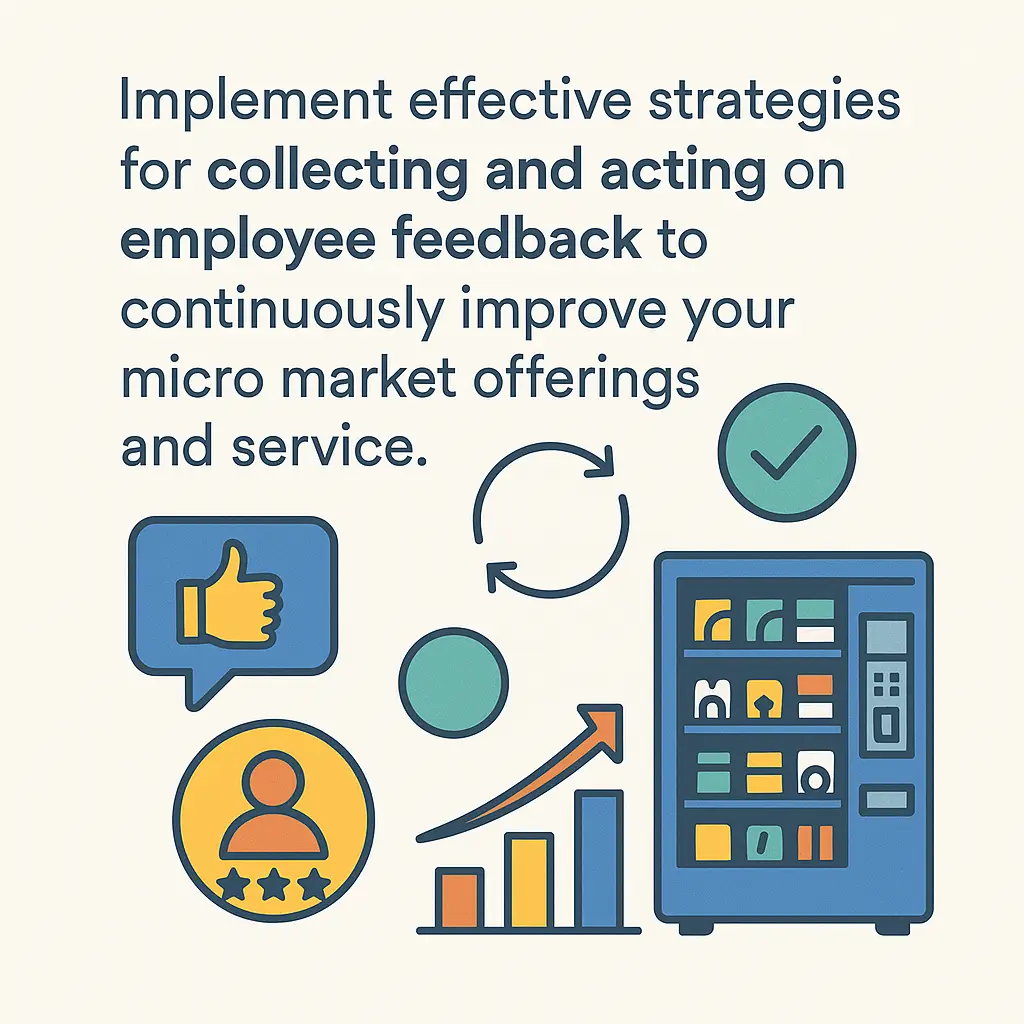Micro Market Employee Feedback Strategies
Implement effective strategies for collecting and acting on employee feedback to continuously improve your micro market offerings and service.
Back to Micro Market Services ResourcesImplement effective strategies for collecting and acting on employee feedback to continuously improve your micro market offerings and service.
Back to Micro Market Services ResourcesUnlocking the full potential of your office micro market depends on understanding what your employees truly want. Strategic feedback collection ensures offerings are always relevant and satisfying.
![]() Tailor product selections to actual employee preferences
Tailor product selections to actual employee preferences
![]() Enhance the overall micro market experience and satisfaction
Enhance the overall micro market experience and satisfaction
![]() Drive engagement and utilization of your breakroom amenity
Drive engagement and utilization of your breakroom amenity

Modern workplaces understand the value of employee amenities, and micro markets have emerged as a top choice for convenient, in-office refreshments. However, a micro market's true success lies not just in its presence, but in its ability to adapt and satisfy the evolving needs of its users. Implementing effective employee feedback strategies is paramount to achieving this. By actively listening to your team, you can transform your micro market from a simple convenience into a highly valued perk, much like optimizing services for an entire facility, as outlined in strategies for vending services for office administrators.
The first step in collecting useful feedback is making it easy for employees to provide it. Consider multiple avenues that cater to different preferences. Anonymous online surveys are excellent for honest, unfiltered opinions, especially regarding pricing and perceived value. Physical suggestion boxes placed within the micro market or breakroom can also capture ideas on the spot. Dedicated email addresses or direct lines of communication allow for more detailed input or immediate concerns. For valuable insights into the installation process, which can impact initial user experience, explore how to set up a micro market in your office.
When soliciting feedback, be specific. Ask about current product variety (e.g., "Are there enough healthy options?", "What snacks would you like to see?"), pricing fairness, overall market cleanliness, and the functionality of self-checkout kiosks. Critically, the feedback loop must extend beyond collection. Regularly review the input, identify trends, and—most importantly—take action. This might involve adjusting inventory, addressing maintenance issues, or even changing layout based on popular suggestions. Transparent communication about changes made based on their input reinforces that employee voices are heard and valued, fostering a sense of ownership and increasing engagement. This commitment to user satisfaction is a hallmark of successful management, similar to the considerations discussed in inventory management in micro markets.
Continuously seeking and responding to employee feedback ensures your micro market remains a dynamic, employee-centric amenity that truly enhances the workplace experience. It fosters a positive office culture and maximizes the return on your investment in employee well-being.
Employee feedback is crucial for micro markets as it directly informs product selection, service quality, and overall satisfaction, ensuring the offerings meet actual user needs.
Effective methods include anonymous suggestion boxes, digital surveys via QR codes, direct email feedback channels, and regular focus groups.
Anonymous channels encourage honest opinions on pricing, product variety, and service, allowing employees to share concerns without fear of reprisal.
Prioritize feedback on product freshness, desired new items, pricing concerns, equipment functionality, and cleanliness of the market area.
Collecting feedback quarterly or bi-annually is generally recommended to capture changing preferences and address issues promptly without survey fatigue.
Technology, such as touchscreens on kiosks, mobile apps, and online survey platforms, streamlines the feedback process and provides data for analysis.
Feedback identifies popular items, highlights missing preferences (e.g., vegan, gluten-free), and helps remove underperforming products, leading to optimized inventory.
Yes, communicating how feedback has been acted upon builds trust and encourages continued participation, showing employees their input is valued.
Feedback can pinpoint issues with restocking frequency, equipment maintenance, or payment processing, allowing for targeted service improvements.
Common challenges include low participation rates, ensuring anonymity, managing diverse preferences, and translating qualitative feedback into actionable steps.